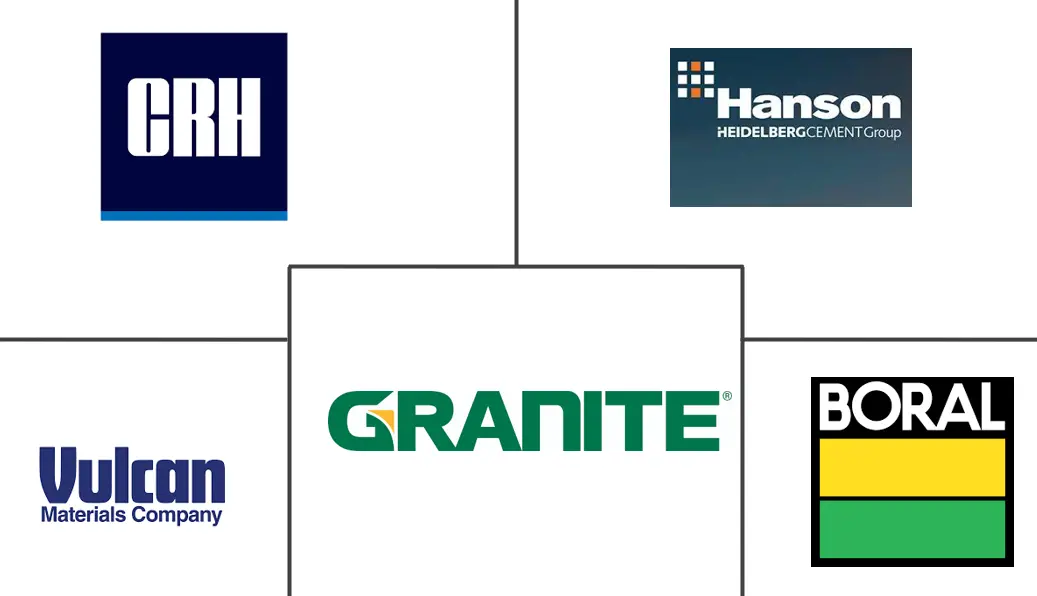Lightweight Construction Materials Market Size and Share
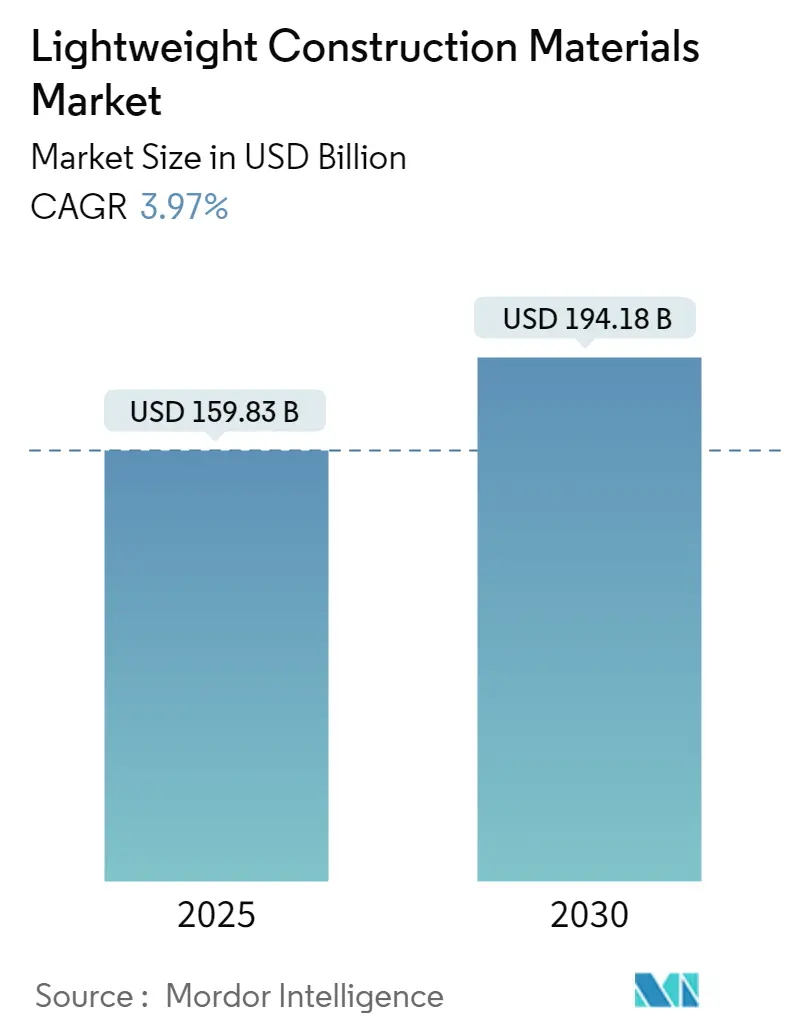
Lightweight Construction Materials Market Analysis by Mordor Intelligence
The Lightweight Construction Materials Market size is estimated at USD 159.83 billion in 2025, and is expected to reach USD 194.18 billion by 2030, at a CAGR of 3.97% during the forecast period (2025-2030).
- As the world's population becomes increasingly urbanized, there is a growing demand for high-rise buildings. Lightweight construction materials can be used to reduce the weight of these buildings, which can save on foundation costs and reduce the risk of earthquakes. For example, the North American urban population for 2022 was 308,798,139, a 0.77% increase from 2021.
- The North American urban population for 2021 was 306,441,356, a 0.44% increase from 2020. The North American urban population for 2020 was 305,103,974, a 1.22% increase from 2019. Furthermore, in 2022, the degree of urbanization worldwide was at 57 percent. North America was the region with the highest level of urbanization, with over four-fifths of the population residing in urban areas.
- Lightweight construction materials can help to improve the energy efficiency of buildings by reducing the amount of heat that is lost through the walls and roof. For instance, the value of investments in energy-efficient buildings in H1 2023 was higher in Europe than in any other region. Investments for that market in China amounted to USD 22 billion, which was somewhat lower than in the United States (USD 28 billion). These investments are necessary to reduce the environmental impact of buildings, as they were responsible for a significant share of global greenhouse gas emissions. These materials can help to reduce the environmental impact of construction by using fewer raw materials and producing less waste.
- Lightweight construction materials play a crucial role in the aerospace and defense sectors, enabling the development of highly efficient and durable structures for aircraft, spacecraft, and defense vehicles. These materials contribute to significant weight reduction, enhancing fuel efficiency, increasing payload capacity, and improving overall performance. Since 2013, a total of approximately USD 272 billion of equity investments have been made in space companies worldwide. United States space companies have accounted for almost 47 percent of the total investment, followed by China with 29 percent.
Global Lightweight Construction Materials Market Trends and Insights
Building & Construction segment Holds the prominent share of Global Market
- The buildings and construction segment is a major driver of the lightweight construction materials market, accounting for a significant portion of global demand. Lightweight materials offer several advantages that make them particularly well-suited for construction applications, leading to their widespread adoption in this sector.
- Lightweight construction materials significantly reduce the overall weight of a building, which has several benefits. It minimizes the load on foundations, leading to lower foundation costs and improved seismic resistance. Additionally, it reduces transportation expenses for building materials and enables the construction of taller and more slender structures.
- According to industry sources, the revenue of the global construction industry is expected to grow steadily over the next years. In 2030, it is projected to be more than twice as big as it was in 2020. The size of the construction market amounted to USD 6.4 trillion in 2020, and it is expected to reach USD 14.4 trillion in 2030.
- Lightweight materials offer greater design flexibility and enable the creation of unique architectural features. Their versatility allows architects and designers to experiment with different shapes, forms, and finishes, enhancing the aesthetic appeal of buildings. The prefabricated nature of many lightweight construction materials allows for faster assembly on-site, reducing construction time and labor costs. This is particularly beneficial for large-scale projects and in areas with limited skilled labor availability.
- Lightweight materials often possess superior thermal insulation properties, helping to regulate indoor temperatures and reduce energy consumption. This is particularly important in buildings seeking to achieve energy efficiency certifications and meet environmental sustainability goals.
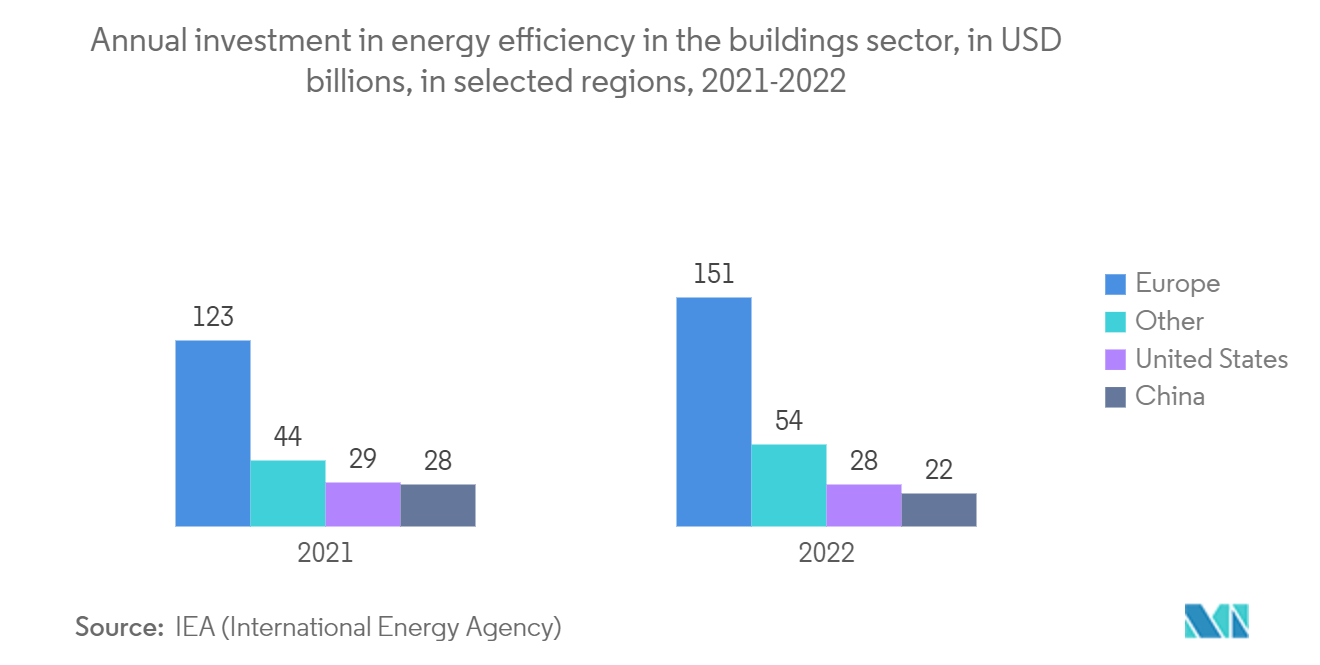
Europe to Constitute Major Share of Global Lightweight Construction Materials Market
- Europe is expected to hold a significant market share in the global lightweight construction materials market. European countries have implemented stringent energy efficiency regulations for buildings, driving the demand for lightweight construction materials that offer better thermal insulation and reduce energy consumption. Lightweight materials like cross-laminated timber (CLT), autoclaved aerated concrete (AAC), and expanded polystyrene (EPS) offer superior thermal insulation properties, reducing energy consumption and lowering carbon emissions.
- Furthermore, Europe is a highly urbanized region with a growing population and increasing demand for new buildings and infrastructure. Lightweight materials play a crucial role in optimizing building designs, reducing construction time, and minimizing environmental impact. Europe has a well-established manufacturing base for lightweight construction materials, with leading producers like Germany, Austria, and Italy. This strong supply chain ensures the availability of high-quality materials at competitive prices.
- The growth is being driven by several factors, including the increasing demand for energy-efficient buildings, the need to reduce the weight of construction materials to improve transportation efficiency, and the growing popularity of off-site construction methods. For example, CLT is being used to construct a new office building in London. CLT is a type of engineered wood that is made up of layers of timber that are glued together. It is a strong and lightweight material with fire-resistant properties.
- Furthermore, AAC is used to construct schools in Germany. AAC is a type of lightweight concrete that is made by mixing cement, sand, lime, and water with air. It is a strong and insulating material with fire-resistant properties.
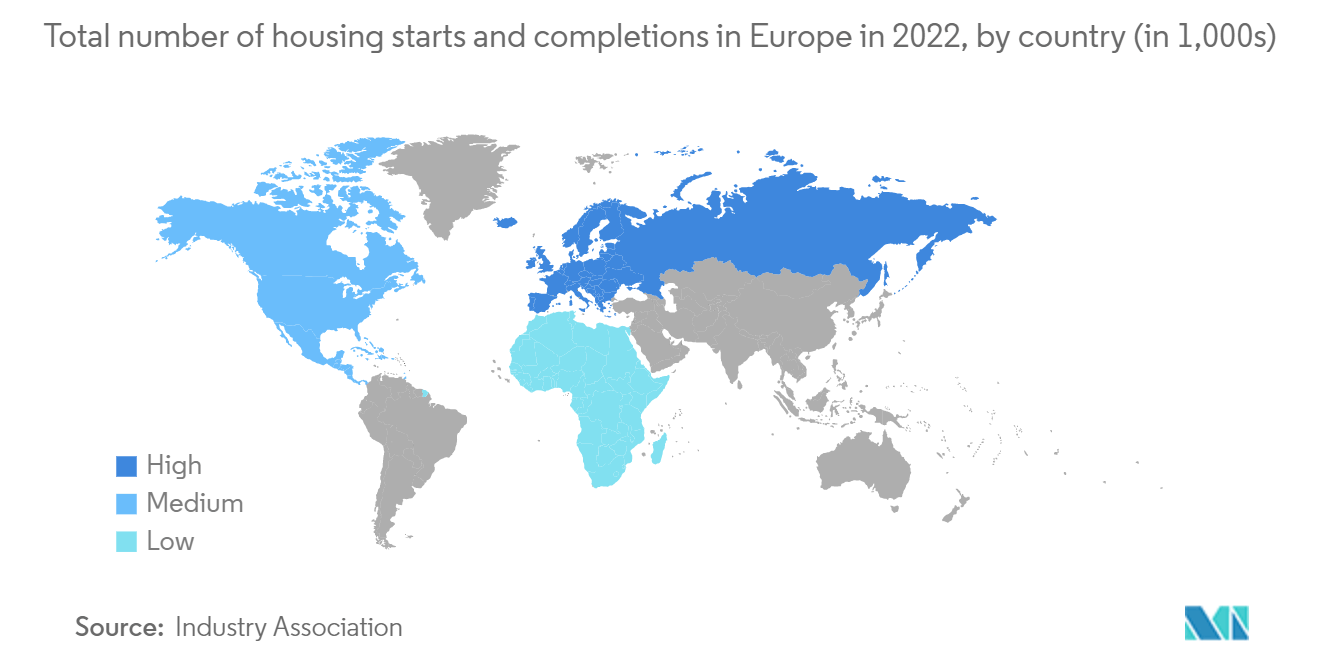
Competitive Landscape
The lightweight construction materials market is fragmented in nature, with a mix of global and regional players. The market is expected to grow during the forecast period due to several factors, such as urbanization, sustainability investments, and growing economies. The major players in this market are HeidelbergCement, Granite, Trinity, James Hardie, and Hanson.
Lightweight Construction Materials Industry Leaders
-
Granite
-
Trinity
-
Hanson
-
CRH
-
James Hardie
- *Disclaimer: Major Players sorted in no particular order
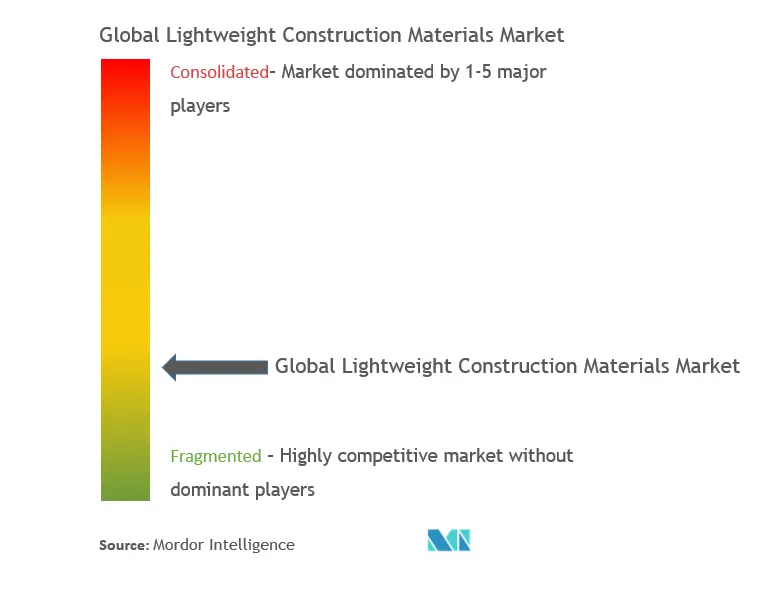
Recent Industry Developments
- August 2023: James Hardie Building Products Inc., a subsidiary of James Hardie Industries plc and the North American leader in fiber cement home siding and exterior design solutions, announced a significant national agreement with D.R. Horton, Inc., the largest homebuilder in the United States. In this landmark partnership, James Hardie becomes D.R. Horton's exclusive national supplier for the hard siding and trim category, extending through December 2026.
- June 2023: Boral Limited (“Boral”) actively participated in the largest crumbed rubber asphalt demonstration project in Australia. Boral has contributed 2000 tonnes of sustainable pavement material, along with 1200 tonnes of controlled asphalt mix for paving across eight local Sydney council streets. This initiative, incorporating recycled rubber from end-of-life car and truck tires, aims to enhance the sustainability and longevity of council roads.
Global Lightweight Construction Materials Market Report Scope
Lightweight construction materials are materials that have a low density compared to traditional construction materials, such as concrete or steel. They are typically used in applications where weight is a critical factor, such as in the construction of aircraft, automobiles, and high-rise buildings. Lightweight construction materials can also be used to improve energy efficiency and reduce construction costs.
The lightweight construction materials market is segmented by product type (bricks, wood, concrete, and others), construction type (residential construction, commercial construction, industrial construction, and infrastructure), and geography (North America, Europe, Asia-Pacific, Latin America, and Middle East & North Africa).
The report offers market size and forecast for the lightweight construction materials market in value (USD) for all the above segments.
| Wood |
| Brics |
| Concrete |
| Other Product Types |
| Residential |
| Commercial |
| Industrial |
| Infrastructure |
| North America |
| Europe |
| Asia-Pacific |
| Middle East & Africa |
| Latin America |
| By Product Type | Wood |
| Brics | |
| Concrete | |
| Other Product Types | |
| By Constrution Type | Residential |
| Commercial | |
| Industrial | |
| Infrastructure | |
| By Geography | North America |
| Europe | |
| Asia-Pacific | |
| Middle East & Africa | |
| Latin America |
Key Questions Answered in the Report
How big is the Lightweight Construction Materials Market?
The Lightweight Construction Materials Market size is expected to reach USD 159.83 billion in 2025 and grow at a CAGR of 3.97% to reach USD 194.18 billion by 2030.
What is the current Lightweight Construction Materials Market size?
In 2025, the Lightweight Construction Materials Market size is expected to reach USD 159.83 billion.
Who are the key players in Lightweight Construction Materials Market?
Granite, Trinity, Hanson, CRH and James Hardie are the major companies operating in the Lightweight Construction Materials Market.
Which is the fastest growing region in Lightweight Construction Materials Market?
Asia Pacific is estimated to grow at the highest CAGR over the forecast period (2025-2030).
Which region has the biggest share in Lightweight Construction Materials Market?
In 2025, the Europe accounts for the largest market share in Lightweight Construction Materials Market.
What years does this Lightweight Construction Materials Market cover, and what was the market size in 2024?
In 2024, the Lightweight Construction Materials Market size was estimated at USD 153.48 billion. The report covers the Lightweight Construction Materials Market historical market size for years: 2019, 2020, 2021, 2022, 2023 and 2024. The report also forecasts the Lightweight Construction Materials Market size for years: 2025, 2026, 2027, 2028, 2029 and 2030.
Page last updated on:
Lightweight Construction Materials Market Report
Statistics for the 2025 Lightweight Construction Materials market share, size and revenue growth rate, created by Mordor Intelligence™ Industry Reports. Lightweight Construction Materials analysis includes a market forecast outlook for 2025 to 2030 and historical overview. Get a sample of this industry analysis as a free report PDF download.
